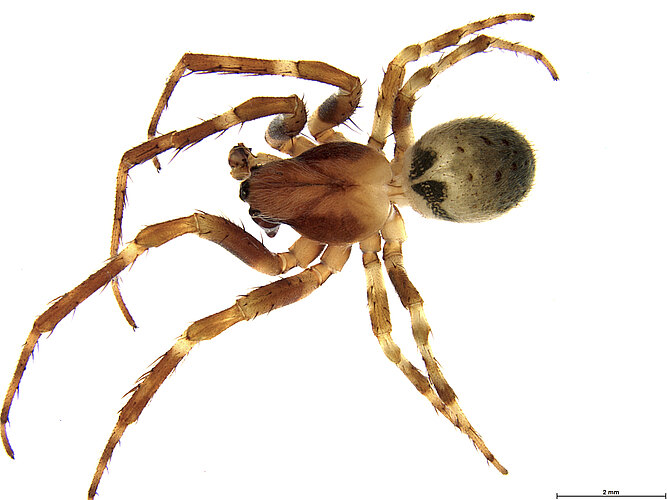Leaf-curling Orb-weaver Leviana dimidiata (L. Koch, 1871)
Fauna Portal species: 6584Diagnosis
(after Framenau & Kuntner 2022): Leviana dimidiata is most similar to L. folium in both somatic (size, colouration) and genitalic morphology. However, they can be clearly separated by the abdominal pattern, particularly by the shape of the black anterior shoulder marks and lateral lines. In L. dimidiata, the anterior black marks and lateral lines form an obtuse internal angle, whereas in L. folium this angle is acute. Male pedipalp morphology differs subtly in some key sclerites; for example, the terminal apophysis has a sclerotised tip in L. dimidiata which is absent in L. folium, the conductor is more prominent and more elongated and the spine in the basal arch of the median apophysis is comparatively much larger. The base of the scape of the female epigyne protrudes further anteriorly in L. dimidiata than in L. folium.
Status
- native
Australia
- Australian Capital Territory
- New South Wales
- Queensland
- Victoria
Similar Species
Publications
Framenau VW, Kuntner M (2022): The new Australian leaf-curling orb-weaving spider genus Leviana (Araneae, Araneidae). Evolutionary Systematics. 6: 103 - 133
Araneae (Spiders)
- Actinopodidae
- Anamidae
- Araneae fam. indet.
- Araneidae
- Abba
- Acroaspis
- Anepsion
- Arachnura
- Araneidae gen. indet.
- Argiope
- Austracantha
- Backobourkia
- Bijoaraneus
- Carepalxis
- Celaenia
- Courtaraneus
- Cyclosa
- Cyrtobill
- Cyrtophora
- Dolophones
- Eriovixia
- Gea
- Genus 2199 ('Cucullus')
- Genus 239 (cf. Scoloderus)
- Genus 2775 (talipedatus gp)
- Genus 3241 ('Corargiope')
- Genus 3271 (mangrove larinoid)
- Genus 3274
- Genus 3313 (psittacinus gp)
- Genus 3338 (acuminatus gp)
- Genus 3339 (albotriangulus gp)
- Genus 3340 (speculabundus gp)
- Genus 3345 (dehaani gp)
- Genus 3346
- Genus 3347 (rainbowi gp)
- Genus 3348
- Hortophora
- Kangaraneus
- Larinia
- Lariniophora
- Leviana
- Leviaraneus
- Mangrovia
- Nemoscolus
- Neoscona
- Novakiella
- Novaranea
- Paraplectanoides
- Plebs
- Poltys
- Quokkaraneus
- Salsa
- Socca
- Soccaraspis
- Telaprocera
- Trichonephila
- Venomius
- Yowie
- Abba
- Archaeidae
- Argyronetidae
- Arkyidae
- Barychelidae
- Cheiracanthiidae
- Clubionidae
- Corinnidae
- Cycloctenidae
- Deinopidae
- Desidae
- Dictynidae
- Filistatidae
- Gnaphosidae
- Halonoproctidae
- Hersiliidae
- Idiopidae
- Lamponidae
- Linyphiidae
- Lycosidae
- Mimetidae
- Miturgidae
- Mysmenidae
- Nicodamidae
- Oecobiidae
- Oonopidae
- Oxyopidae
- Philodromidae
- Pholcidae
- Pisauridae
- Prodidomidae
- Salticidae
- Scytodidae
- Segestriidae
- Selenopidae
- Sparassidae
- Symphytognathidae
- Tetrablemmidae
- Tetragnathidae
- Theridiidae
- Thomisidae
- Trachelidae
- Trachycosmidae
- Trochanteriidae
- Uloboridae
- Zodariidae
- Zoropsidae
All classes
- Arachnida
- Crustacea
- Entognatha
- Gastropoda
- Insecta
- Orthoptera - Caelifera (Grasshoppers)
- Hymenoptera excl. Formicidae (bees and wasps)
- Blattodea s. str. (Cockroaches)
- Coleoptera (Beetles)
- Dermaptera (earwigs)
- Diptera (flies, mosquitos)
- Entomobryomorpha (slender springtails)
- Hemiptera - Heteroptera (True Bugs)
- Hemiptera - Sternorrhyncha (aphids, scales etc.)
- Hemiptera - Auchenorrhyncha (cicadas, planthoppers)
- Hymenoptera - Formicidae (Ants)
- Trichoptera (Caddisflies)
- Zygentoma (silverfish)
- Myriapoda

